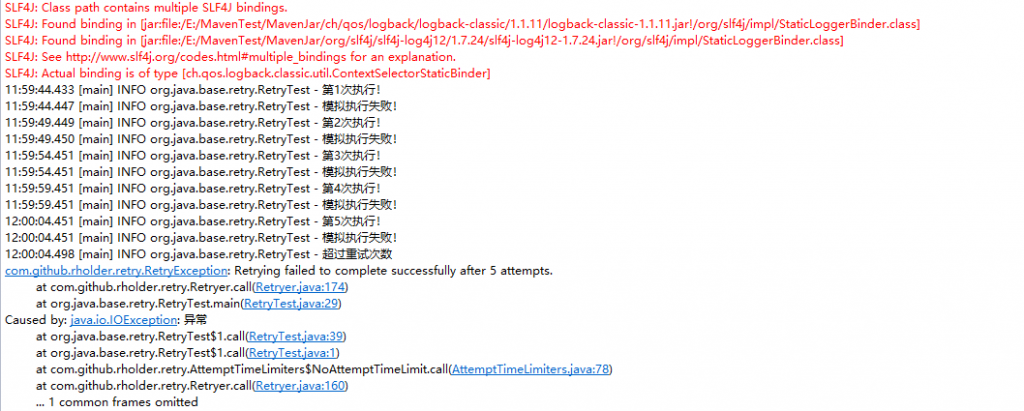重试利器之Guava-Retryer
写在前面
在日常开发中,我们经常会遇到需要调用外部服务和接口的场景。外部服务对于调用者来说一般都是不可靠的,尤其是在网络环境比较差的情况下,网络抖动很容易导致请求超时等异常情况,这时候就需要使用失败重试策略重新调用 API 接口来获取。重试策略在服务治理方面也有很广泛的使用,通过定时检测,来查看服务是否存活(Active)。 Guava Retrying是一个灵活方便的重试组件,包含了多种的重试策略,而且扩展起来非常容易。 用作者的话来说:This is a small extension to Google’s Guava library to allow for the creation of configurable retrying strategies for an arbitrary function call, such as something that talks to a remote service with flaky uptime.使用Guava-retrying你可以自定义来执行重试,同时也可以监控每次重试的结果和行为,最重要的基于 Guava 风格的重试方式真的很方便。
代码示例
- 引入Guava-retry
<guava-retry.version>2.0.0</guava-retry.version>
<dependency>
<groupId>com.github.rholder</groupId>
<artifactId>guava-retrying</artifactId>
<version>${guava-retry.version}</version>
</dependency>- 定义实现Callable接口的方法,以便Guava retryer能够调用
package org.java.base.retry;
import java.io.IOException;
import java.util.concurrent.Callable;
import java.util.concurrent.ExecutionException;
import java.util.concurrent.TimeUnit;
import org.slf4j.Logger;
import org.slf4j.LoggerFactory;
import com.github.rholder.retry.RetryException;
import com.github.rholder.retry.Retryer;
import com.github.rholder.retry.RetryerBuilder;
import com.github.rholder.retry.StopStrategies;
import com.github.rholder.retry.WaitStrategies;
import com.google.common.base.Predicates;
public class RetryTest {
private static final Logger logger = LoggerFactory.getLogger(RetryTest.class);
public static void main(String[] args){
Retryer<Boolean> retryer = RetryerBuilder.<Boolean>newBuilder()
.retryIfResult(Predicates.<Boolean>isNull())// 设置自定义段元重试源
.retryIfExceptionOfType(Exception.class)// 设置异常重试源
.retryIfRuntimeException()// 设置异常重试源
.withStopStrategy(StopStrategies.stopAfterAttempt(5))// 设置重试5次,同样可以设置重试超时时间
.withWaitStrategy(WaitStrategies.fixedWait(5L, TimeUnit.SECONDS))// 设置每次重试间隔,5秒
.build();
try {
retryer.call(new Callable<Boolean>() {
int i = 0;
@Override
public Boolean call() throws Exception {
i++;
logger.info("第{}次执行!", i);
// do something
if (i<6) {// 模拟错2次
logger.info("模拟执行失败!");
throw new IOException("异常");
}
logger.info("模拟执行成功!");
return true;
}
});
} catch (RetryException e) {
logger.info("超过重试次数", e);
} catch (ExecutionException e) {
logger.info("重试框架异常", e);
}
}
}
简单三步就能使用Guava Retryer优雅的实现重调方法。
接下来对其进行详细说明:
RetryerBuilder是一个factory创建者,可以定制设置重试源且可以支持多个重试源,可以配置重试次数或重试超时时间,以及可以配置等待时间间隔,创建重试者Retryer实例。RetryerBuilder的重试源支持Exception异常对象 和自定义断言对象,通过retryIfException和retryIfResult设置,同时支持多个且能兼容。retryIfException,抛出runtime异常、checked异常时都会重试,但是抛出error不会重试。retryIfRuntimeException只会在抛runtime异常的时候才重试,checked异常和error都不重试。retryIfExceptionOfType允许我们只在发生特定异常的时候才重试,比如NullPointerException和IllegalStateException`都属于runtime异常,也包括自定义的error
.retryIfExceptionOfType(Error.class)// 只在抛出error重试.retryIfExceptionOfType(IllegalStateException.class)
.retryIfExceptionOfType(NullPointerException.class).retryIfException(Predicates.or(Predicates.instanceOf(NullPointerException.class),
Predicates.instanceOf(IllegalStateException.class)))// 返回false重试
.retryIfResult(Predicates.equalTo(false))
//以_error结尾才重试
.retryIfResult(Predicates.containsPattern("_error$")) 
主要接口及策略介绍:
Attempt:一次执行任务;
AttemptTimeLimiter:单次任务执行时间限制(如果单次任务执行超时,则终止执行当前任务);
BlockStrategies:任务阻塞策略(通俗的讲就是当前任务执行完,下次任务还没开始这段时间做什么……),默认策略为:BlockStrategies.THREAD_SLEEP_STRATEGY 也就是调用 Thread.sleep(sleepTime);
RetryException:重试异常;
RetryListener:自定义重试监听器,可以用于异步记录错误日志;
StopStrategy:停止重试策略,提供三种:
StopAfterDelayStrategy:设定一个最长允许的执行时间;比如设定最长执行10s,无论任务执行次数,只要重试的时候超出了最长时间,则任务终止,并返回重试异常RetryException;NeverStopStrategy:不停止,用于需要一直轮训知道返回期望结果的情况;StopAfterAttemptStrategy:设定最大重试次数,如果超出最大重试次数则停止重试,并返回重试异常;
WaitStrategy:等待时长策略(控制时间间隔),返回结果为下次执行时长:
FixedWaitStrategy:固定等待时长策略;RandomWaitStrategy:随机等待时长策略(可以提供一个最小和最大时长,等待时长为其区间随机值)IncrementingWaitStrategy:递增等待时长策略(提供一个初始值和步长,等待时间随重试次数增加而增加)ExponentialWaitStrategy:指数等待时长策略;FibonacciWaitStrategy:Fibonacci 等待时长策略;ExceptionWaitStrategy:异常时长等待策略;CompositeWaitStrategy:复合时长等待策略;
参考资料:
http://blog.csdn.net/aitangyong/article/details/53894997 https://segmentfault.com/a/1190000006918410 http://blog.csdn.net/aitangyong/article/details/53886293 http://baijiahao.baidu.com/s?id=1575327487081031&wfr=spider&for=pc http://www.cnblogs.com/jianzh5/p/6651799.html
正文到此结束
- 本文标签: Guava-Retryer
- 版权声明: 本文由HARRIES原创发布,转载请遵循《署名-非商业性使用-相同方式共享 4.0 国际 (CC BY-NC-SA 4.0)》许可协议授权
- 本文海报: 生成海报一 生成海报二
热门推荐
相关文章
Loading...











![[HBLOG]公众号](https://www.liuhaihua.cn/img/qrcode_gzh.jpg)

